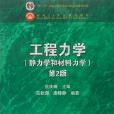內容簡介
本書是
普通高等教育“十一五”國家級規劃教材,是在第1版的基礎上,根據我國高等教育和教學改革的發展趨勢,以及素質教育與創新精神培養的要求,在國家面向21世紀課程教學內容與體系改革項目的基礎上,充分反映近年來基礎力學教學第一線的新成果、新經驗而修訂的。
根據最新的課程教學基本要求,以及教學第一線很多教師的意見,本版的體系基本與第1版相同,在內容上作了一些調整,刪去了能量法一章,將緒論改為工程力學課程概論,同時對部分內容進行了改寫,在概念、原理的敘述方面作了一些改進,並按照國家標準,將名詞術語、量和單位的名稱、符號規範化。
本書分靜力學和材料力學兩篇。靜力學篇包括靜力學基礎、力系的簡化和靜力學平衡問題等3章;材料力學篇包括材料力學的基本概念、軸向拉伸與壓縮、圓軸扭轉、
彎曲強度、彎曲剛度、應力狀態與強度理論、組合受力與變形桿件的強度計算、壓桿的穩定性問題、動載荷與疲勞強度簡述等9章。
本書可作為高等學校工科本科非機類各專業工程力學課程的教材,也可供獨立學院、高職高專、成人高校師生及有關工程技術人員參考。
目錄
工程力學課程概論
§1 工程力學與工程密切相關
§2 工程力學的主要內容與分析模型
2-1 工程力學的主要內容
2-2 工程力學的兩種分析模型
§3 工程力學的分析方法
3-1 兩種不同的理論分析方法
3-2 工程力學的實驗分析方法
3-3 工程力學的計算機分析方法
第一篇 靜力學
第1章 靜力學基礎
§1-1 力和力矩
§1-2 力偶及其性質
§1-3 約束與約束力
§1-4 平衡的概念
§1-5 受力分析方法與過程
§1-6 結論與討論
習題
第2章 力系的簡化
§2-1 力系等效與簡化的概念
§2-2 力系簡化的基礎——力向一點平移定理
§2-3 平面力系的簡化
§2-4 固定端約束的約束力
§2-5 結論與討論
習題
第3章 靜力學平衡問題
§3-1 平面力系的平衡條件與平衡方程
§3-2 簡單的空間力系平衡問題
§3-3 簡單的剛體系統平衡問題
§3-4 考慮摩擦時的平衡問題
§3-5 結論與討論
習題
第二篇 材料力學
第4章 材料力學的基本概念
§4-1 關於材料的基本假定
§4-2 彈性桿件的外力與內力
§4-3 彈性體受力與變形特點
§4-4 桿件橫截面上的應力
§4-5 正應變與切應變
§4-6 線彈性材料的應力-應變關係
§4-7 桿件受力與變形的基本形式
§4-8 結論與討論
習題
第5章 軸向拉伸與壓縮
§5-1 軸力與軸力圖
§5-2 拉壓桿件的應力與變形
§5-3 拉壓桿件的強度計算
§5-4 拉伸與壓縮時材料的力學性能
§5-5 結論與討論
習題
第6章 圓軸扭轉
§6-1 工程上傳遞功率的圓軸及其扭轉變形
§6-2 扭矩與扭矩圖
§6-4 圓軸扭轉時的切應力分析
§6-5 圓軸扭轉時的強度與剛度計算
§6-6 結論與討論
習題
§7-1 工程中的彎曲構件
§7-2 剪力方程與彎矩方程
§7-3 剪力圖與彎矩圖
§7-4 與應力分析相關的截面圖形幾何量
§7-5 平面彎曲時梁橫截面上的正應力
§7-6 平面彎曲正應力公式套用舉例
§7-7 梁的強度計算
§7-8 結論與討論
習題
第8章 彎曲剛度
§8-1 彎曲變形與位移的基本概念
§8-2 小撓度微分方程及其積分
§8-3 工程中的疊加法
§8-4 簡單的靜不定梁
§8-5 彎曲剛度計算
§8-6 結論與討論
習題
第9章 應力狀態與強度理論
§9-1 基本概念
§9-3 應力狀態中的主應力與最大切應力
*§9-4 分析應力狀態的應力圓方法
§9-5 一般應力狀態下的應力-應變關係
應變能密度§9-6 一般應力狀態下的強度條件
§9-7 結論與討論
*9-7-3 關於應力狀態的不同的表示方法
習題
第10章 組合受力與變形桿件的強度計算
§10-1 斜彎曲
§10-2 拉伸(壓縮)與彎曲的組合
§10-3 彎曲與扭轉的組合
§10-4 薄壁容器強度設計簡述
§10-5 結論與討論
習題
第11章 壓桿的穩定性問題
§11-1 壓桿穩定性的基本概念
§11-2 細長壓桿的臨界載荷——歐拉臨界力
§11-3 長細比的概念 三類不同壓桿的判斷
§11-4 壓桿穩定性計算
§11-5 壓桿穩定性計算示例
§11-6 結論與討論
習題
第12章 動載荷與疲勞強度簡述
§12-1 等加速直線運動時構件上的慣性力與動應力
§12-2 旋轉構件的受力分析與動應力計算
§12-3 衝擊載荷與衝擊應力計算
§12-4 疲勞強度簡述
§12-5 疲勞極限與應力-壽命曲線
§12-6 影響疲勞極限的因素
§12-7 基於無限壽命設計方法的疲勞強度設計
§12-8 結論與討論
習題
附錄 型鋼規格表
習題答案
索引
參考文獻
Synopsis
Contents
主編簡介
Course summary for engineering mechanics
§1 Engineering mechanics is nearly related with engineering
§2 Main contents and analysis model of engineering mechanics
2-1 Main contents of engineering mechanics
2-2 Two kinds of analysis model of engineering mechanics
§3 Analysis methods of engineering mechanics
3-1 Two different kinds of theoretical analysis methods
3-2 Experimental analysis methods of engineering mechanics
3-3 Computer analysis methods of engineering mechanics
Part I Statics
Chapter 1 Fundamental statics
§1-1 Force and force moment for a given point
§1-2 Moment of a couple and its characteristic
§1-3 Constraints and constraint force
§1-4 Concept of equilibrium
§1-5 Analysis method and process
§1-6 Summary and discussion
Problems and exercises
Chapter 2 Reduction of a system of forces
§2-1 Concepts of force systems equivalent and reduction
§2-2 Foundation of reduction—theorem of translation of force
§2-3 Reduction of planar forces system
§2-4 Constraint forces of fixed end support constraint
§2-5 Summary and discussion
Problems and exercises
Chapter 3 Statics equilibrium problems
§3-1 Equilibrium conditions and equations of planar forces system
§3-2 Equilibrium problems of simple spatial force system
§3-3 Equilibrium problems of simple rigid body system
§3-4 Equilibrium problems of the body with friction
§3-5 Summary and discussion
Problems and exercises
Part II Mechanics of materials
Chapter 4 Fundamental summary of the mechanics of materials
§4-1 Basic assumptions of the materials
§4-2 External and internal force of elastic bar
§4-3 Stress and deformation characteristics of the elastic body
§4-4 Stress on the cross section of bar
§4-5 Normal strain and shearing strain
§4-6 Stress-strain relationship of linear elastic material
§4-7 Basic forms of stress and deformation of bar
§4-8 Summary and discussion
Problems and exercises
Chapter 5 Axial tension or compression
§5-1 Axial force and its diagram
§5-2 Stress and deformation of axially loaded bar
§5-3 Strength calculation
§5-4 Mechanic properties of materials under tension or compression
§5-5 Summary and discussion
*5-5-3 Stress distribution near the loaded point
*5-5-4 Concept of the stress concetration
*5-5-5 Summary of statically indeterminate problem under tension or compression
Problems and exercises
Chapter 6 torsion of circular shaft
§6-1 Circular shaft transfering power in engineering and its torsiondeformation
§6-2 Torsional moment and torque diagram
§6-3 Equivalent law of shear stress
§6-4 Torional stress analysis on torsion of circular shaft
§6-5 Strength and stiffness caculation on torsion of circular shaft
§6-6 Summary and discussion
Chapter 7 Bending strength
§7-1 Bending elements in engineering
§7-2 Equations of shear force and bending moment
§7-3 Diagrams of shearing force and bending moment
§7-4 Geometric properties of cross section relating to stress analysis
§7-5 Normal stress on the cross section of beam bended in one plane
§7-6 Examples for the applications of the equation of plane bendingnormal stress
§7-7 Strength comptutation of beams
§7-8 Summary and discussion
Problems and exercises
Chapter 8 Bending Stiffness
§8-1 Basic concepts of deformation and displacement of beams
§8-2 Differential equation of small deflection of beams and its integration
§8-3 Superposition method in engineering
§8-4 Simple statically indeterminate beam
§8-5 Bending Stiffness Calculation
§8-6 Summary and discussion
Problems and exercises
Chapter 9 State of stress and theory of strength
§9-1 Basic concepts
§9-2 Stress analysis on arbitrary direction under state of stress of plane
§9-3 Principal stress and maximum shear stress under state of stress
*§9-4 Stress circle method of analysing state of stress
§9-5 Stress-strain relation under general state of stress strain energydensity
§9-6 Strength condition under general state of stress
*9-6-2 Second strength theory
§9-7 Summary and discussion
*9-7-3 Different expressions of state of stress
Problems and exercises
Chapter 10 Strength calculation of transformative bar under the combinationforced
§10-1 Skew bending
§10-2 Combination of Axial Tension or Compression and Bending
§10-3 Combination of bending and torsion
§10-4 Sketch of strength design of thin-wall cyclindrical container
§10-5 Summary and discussion
Problems and exercises
Chapter 11 Stability problem of column
§11-1 Basic concept of stability of column
§11-2 Critical load for slender column—Euler's formula
§11-3 Concept of slenderness ratio,three different kinds of columns
§11-4 Stability design of columns
§11-5 Examples for Stability design
§11-6 Summary and discussion
Problems and exercises
Chapter 12 Summary of dynamic load and fatigue strength
§12-1 Interia force and dynamic stress of element during straight-linemotion with uniform acceleration
§12-2 Stress analysis and calculation of dynamic stress of rotated element
§12-3 Calculation of impact load and stress on element
§12-4 Summary of fatigue strength
§12-5 Fatigue limit and stress—life curve
§12-6 Influencing factors on fatigue life
§12-7 Fatigue strength based on finite-life design
§12-8 Summary and discussion
Problems and exercises
Appendix Properites of Rolled-Steel Shapes
Answers
Index
Reference
Synopsis
Contents
A Brief Introduction to the Author

